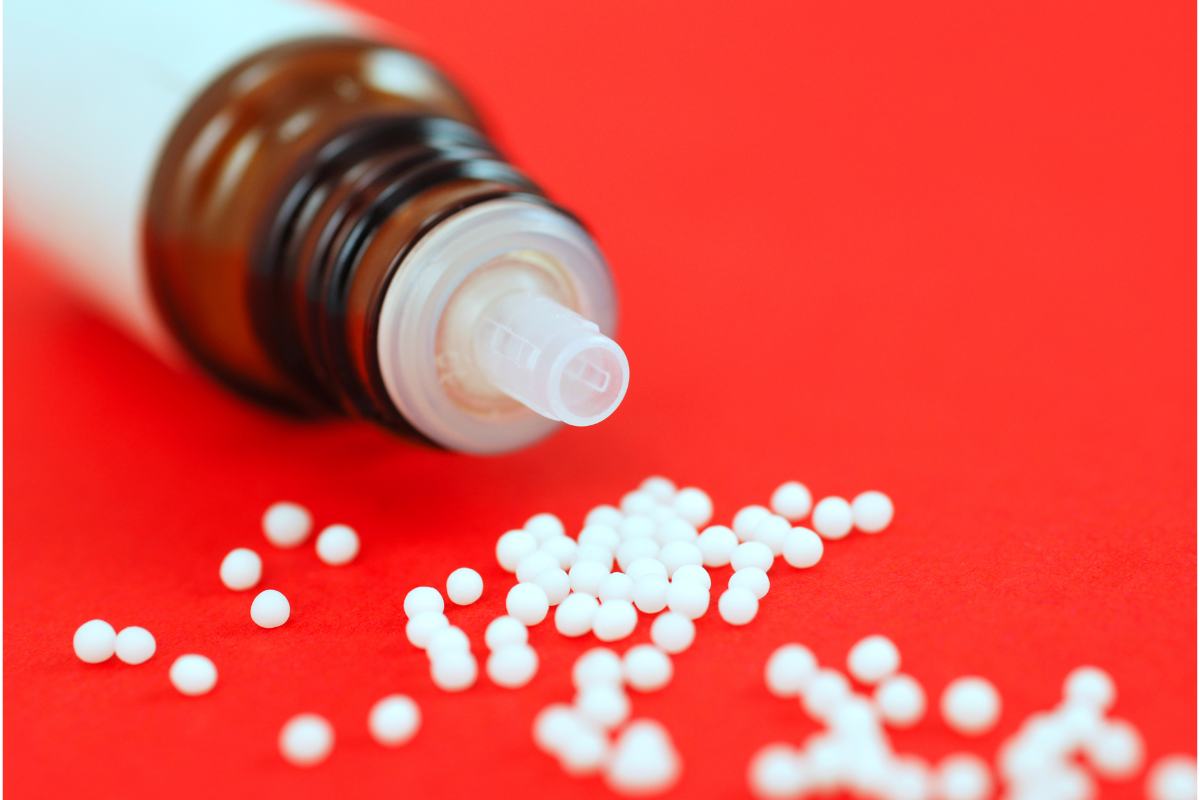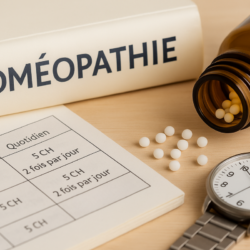A fall? A small local trauma? Homeopathy allows you to intervene quickly and painlessly, so that haematomas are quickly reabsorbed.
Advice on using homeopathy in the event of trauma
It is important to remember that homeopathy, although useful, is not a substitute for conventional medical treatment, especially in the case of serious injuries. Here is some advice on how to use it:
- Medical assessment: Always consult a health professional for an assessment in the event of serious injury.
- Dosage: Carefully follow the dosage instructions for each homeopathic remedy.
- Body reaction: Pay attention to the body’s reaction and adjust treatment if necessary.
Understanding the action of homeopathy on trauma
Homeopathy, a gentle, non-invasive medical practice, offers a unique approach to the treatment of minor traumas such as bruises, superficial cuts and sprains. This method stimulates the body’s natural healing processes, while reducing inflammation and pain.
Basic principles
- Stimulation of the Autoimmune Response: Homeopathic remedies are designed to stimulate the body’s autoimmune response. This means that they encourage the body to use its own healing mechanisms to treat injuries.
- Dilutions and Potentiations: The substances used in homeopathy are extremely diluted, which, according to homeopathic principles, increases their therapeutic potential without causing side effects.
Reduction of inflammation and pain
- Anti-inflammatory action: Several homeopathic remedies have natural anti-inflammatory properties. For example, Arnica montana is frequently used to reduce inflammation and bruising following a shock.
- Pain relief: Homeopathy can also help to reduce the pain associated with mild trauma. Remedies such as Bryonia and Ruta grav are used to relieve muscle and joint pain.
Acceleration of the healing process
- Stimulation of Tissue Regeneration: Certain remedies encourage the regeneration of damaged tissue. Calendula, for example, is used for healing cuts and scrapes.
- Reduction of Bruising and Swelling: Homeopathy can be effective in reducing the appearance of bruising and swelling after trauma, aiding faster cosmetic recovery.
Personalised approach
- Treatment tailored to symptoms: One of the cornerstones of homeopathy is personalised treatment. An experienced homeopath will select a remedy based on a detailed assessment of the patient’s specific symptoms, ensuring a targeted and effective approach.
Integration with other treatments
- Complementarity with conventional medicine: Homeopathic remedies can often be used to complement conventional medical treatments, offering a holistic and multidimensional approach to the treatment of trauma.
In short, homeopathy offers a gentle, natural method of treating mild trauma, stimulating the body’s internal healing and effectively reducing inflammation and pain without the common side effects of conventional medicines.
In all cases: Arnica 7 CH
- 3 granules repeated every 1/4 hour for one hour. Then every two hours for 24 hours and finally 4 times a day, depending on the persistence of the pain and haematoma.
- If the trauma is severe: combine Arnica 15 CH (1 dose-globule twice a day for 48 hours).
- Apply Arnica ointment locally to the haematoma (the “bruise”) 3 times a day. Caution: avoid in the case of an open wound.
- This treatment helps the haematoma to heal. It also allows you to wait for an X-ray diagnosis if one is required. Systematic treatment with Arnica 7 CH may be supplemented as required, depending on the type of trauma.
Homeopathy and bone trauma
- In the case of bone contusion without fracture: add Ruta 7 CH (3 granules 3 times a day).
- In the case of a crack or fracture, as a complement to surgical treatment: Calcarea Phosphorica 7 CH (3 granules 3 times a day) and Ostéocynésine (3 tablets 3 times a day for 8 days, then 2 times a day until consolidation is complete).
- Ostéocynésine from the Boiron laboratory is a mixture of equal parts of Calcarea Ostreica 3D, Calcarea Fluorica 3D and Sulfur Iodatum 4CH). Homeopathic treatment allows bones to consolidate more quickly.
Other cases
- Following a sprain or strain:
- Rhus Toxicodendron 7 CH and Ruta 7 CH: 3 granules of each, 3 times a day.
- Medical consultation recommended if in doubt.
- Ocular trauma or “black eye”:
- Examination by a specialist to check the condition of the eye.
- Ledum Palustre 7 CH: 3 granules, 3 times a day.
- Symphytum 4 or 5 CH: 5 granules every hour, spaced out according to improvement, over 2 days.
- Urgent ophthalmological consultation in the event of redness, intense pain or damage to the eyeball.
- Trauma to the breasts or genitals:
- Bellis Perennis 7 CH: 3 granules, 3 times a day.
- Bleeding (nose, cuts, menstruation, gums):
- China rubra 9 CH: 5 granules, 4 to 6 times a day, depending on intensity.
- For acute bleeding (e.g. epistaxis): Phosphorus 15 CH, 5 granules every 10 minutes for 1 hour, then space out according to improvement.
- Cut by a sharp object (e.g. nail):
- Ledum palustre 5 CH: 5 granules every hour, space out as improvement occurs.
- Combine with Pyrogenium 9 CH: 4 times a day to prevent infection.
- In the case of an incision wound (e.g. finger cut): Staphysagria 9 CH, 5 granules every 2 hours, to be spaced according to the reduction in symptoms. Treatment for 1 week.
- Cut to the genitals or breasts:
- Bellis perennis 4 to 5 CH: 5 granules, morning, noon and evening for 1 week.
- Combine with Conium maculatum 7 or 9 CH: 5 granules, 4 times a day for 1 week.
- Headache or dizziness following head trauma:
- Hypericum perforatum 30 CH: 5 granules, morning and evening for 1 month.
- Headache or migraine relieved by nosebleed:
- Lachesis mutus 7 CH: 5 granules every 3 hours, to be spaced according to improvement.
Homeopathy in the treatment of sports injuries
Sports activities, although essential for maintaining good physical health, can sometimes lead to injuries such as bruises, sprains and muscle pain. In this context, homeopathy is proving to be an effective and gentle method of treatment, particularly suited to the management of these sports injuries.
Arnica montana: the first remedy for physical trauma
Arnica Montana is probably the best-known and most widely used homeopathic remedy for treating physical trauma. Known for its anti-inflammatory and analgesic properties, Arnica is particularly effective in reducing haematomas and relieving pain after a shock. Whether as prevention, by taking a dose before exercise, or as treatment, by administering it immediately after a shock, Arnica helps speed up the healing process.
Ruta Graveolens : Ally for sprains and ligament pain
Ruta Graveolens is another homeopathic remedy frequently used, especially for sprains and ligament pain. This remedy is particularly suitable for pain that is aggravated by movement and improved by heat. Ruta Graveolens not only helps to relieve pain, but also reduces inflammation and promotes the healing of damaged ligaments and tendons.
Recommendations for use in sport
- Prevention: Consider taking Arnica Montana before intense sporting activity to minimise the risk of trauma.
- Immediate treatment: In the event of injury, quickly administer the appropriate homeopathic remedy for optimum effectiveness.
- Dosage and frequency: Follow the specific dosage recommendations for each remedy and adjust according to the severity of the injury and the body’s response.
When should you consult a professional?
Although homeopathy is effective in treating many post-traumatic symptoms, it is crucial to recognise situations requiring professional medical assessment. Knowing when to seek professional help can prevent complications and ensure adequate recovery.
Signs of seriousness
- Intense and persistent pain: If the pain caused by the trauma is intense and does not diminish over time, this may indicate a more serious injury requiring medical attention.
- Inability to Move or Bear Weight: An inability to move a body part or bear weight on a leg or arm may be a sign of a fracture or serious injury.
Alarming symptoms
- Sudden or severe swelling: Rapid or significant swelling may indicate a severe inflammatory reaction or fluid accumulation requiring medical evaluation.
- Colour Changes or Numbness: Colour changes (blueness, excessive paleness) or numbness in the injured area may be signs of circulatory or nerve disorders.
Possible infections
- Redness, heat and pus: If the area around a wound becomes red, warm to the touch, or begins to ooze pus, this may indicate an infection that requires antibiotic treatment.
- Fever: The presence of a fever after trauma can be a sign of infection and requires medical attention.
Limitations of homeopathy
- Assessment of limitations: Homeopathy can be very beneficial in treating mild trauma, but it does have its limitations, especially in serious or complicated injuries.
- Complementarity of Care: It is important to see homeopathy as a complement to conventional medical care, not as a substitute in serious cases.
Importance of early consultation
- Prevention of Complications: Consulting a healthcare professional at the first signs of complications can prevent more serious problems and speed up the healing process.
- Overall assessment: A healthcare professional can assess the patient’s general condition and propose a comprehensive treatment plan, including homeopathic care if necessary.
In summary, although homeopathy is a valuable option for the initial treatment of mild trauma, vigilance is required. Knowing when to consult a healthcare professional is essential for a safe and effective recovery.
Consultation obligatory if
- The trauma leads to loss of consciousness, disturbances of consciousness or nausea, even if these symptoms are mild.
- The pain is very sharp and localised, or if it is difficult to move the limb: this may be a bone trauma.
Homeopathy and post-trauma recovery
Homeopathy plays a significant role in the recovery phase after trauma. By focusing on holistic treatment, it contributes not only to physical healing but also to the patient’s general well-being.
Facilitating physical healing
- Natural stimulation of the body: Homeopathic remedies help to stimulate the body’s natural healing process. By acting in subtle ways, they encourage the body to repair and regenerate damaged tissue.
- Reduction of Post-Traumatic Symptoms: Remedies such as Arnica and Bellis perennis are recognised for their ability to reduce post-traumatic symptoms such as pain, bruising and swelling.
Emotional and psychological support
- Stress and anxiety management: Trauma can often lead to stress and anxiety. Remedies such as Aconitum napellus and Ignatia amara can help manage these emotions, facilitating a more serene recovery.
- Improving sleep: A good night’s sleep is crucial to recovery. Certain homeopathic remedies promote restful sleep, which is essential for the healing process.
Rebalancing the body’s energies
- Global Harmonisation: Homeopathy aims to rebalance the body’s energies. This rebalancing is essential after a trauma, as it helps the body to return to its optimal state of health.
- Prevention of Complications: By treating the body as a whole, homeopathy can help prevent potential complications that could arise after a trauma.
Practical advice for use
- Choosing the right remedy: The choice of homeopathic remedy should be based on the patient’s specific symptoms and general condition. A consultation with a professional homeopath is recommended for a personalised treatment.
- Regular follow-up: Regular follow-up is important to adjust the treatment as recovery progresses.
By incorporating homeopathy into the post-traumatic recovery process, patients can benefit from a more comprehensive healing approach, which takes into account both the physical and emotional aspects of recovery.
Combining homeopathy with other forms of natural medicine
In the quest for a holistic approach to health, homeopathy lends itself admirably to being combined with other forms of natural medicine. This therapeutic synergy can offer a wider spectrum of benefits, particularly in the treatment of physical trauma such as bruises, bumps or muscle aches.
Herbal medicine as a complement to homeopathy
Phytotherapy, which uses plant extracts for their medicinal properties, is particularly complementary to homeopathy. For example, while homeopathic Arnica Montana is reputed to reduce swelling and accelerate the healing of bruises, topical application of arnica in gel or cream form can reinforce this effect.
Using cold compresses with plant extracts
The use of cold compresses impregnated with plant extracts is an effective method of rapidly relieving pain and reducing inflammation. By causing vasoconstriction, cold compresses reduce blood flow to the traumatised area, thereby reducing swelling and bruising. Adding plant extracts such as Calendula or Witch Hazel, known for their soothing and anti-inflammatory properties, maximises the beneficial effects of these compresses.
Tips for effective application
- Choice of Plant Extracts : Select plant extracts suited to the type of trauma. For example, Calendula extract is indicated for damaged and irritated skin, while Witch Hazel is better suited to bruises and swelling.
- Preparation of Compresses: Soak sterile compresses in the chosen plant extract, then chill in the fridge before application.
- Application time: Apply the cold compress to the affected area for approximately 10-15 minutes, several times a day as required.





